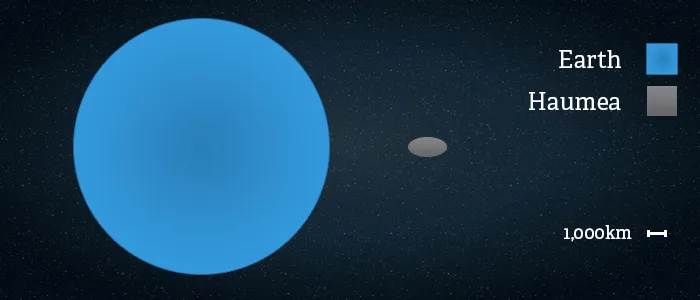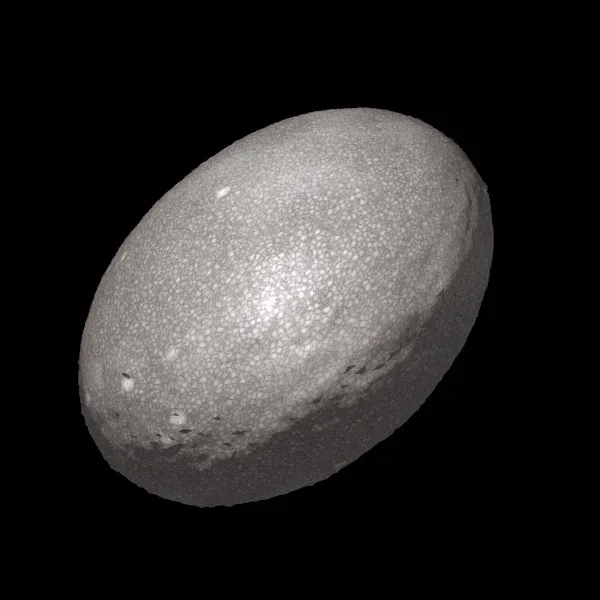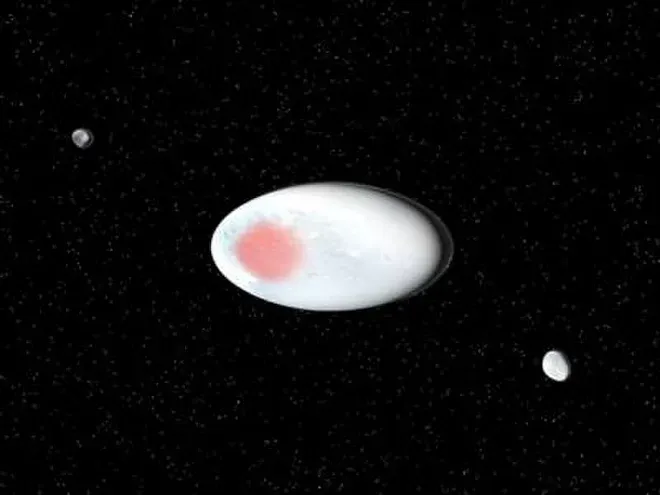Far away from the sun lies the Kuiper Belt, a collection of massive icy objects slowly orbiting the sun. These objects lie past the orbit of Neptune, with the belt's most famous resident being the dwarf planet Pluto. Think of the Kuiper Belt as a much, much, much larger asteroid belt, with much larger worlds contained within it. The objects here are coated in ices that would easily sublimate or melt if they were as close to the sun as Earth is.
Of the Kuiper Belt denizens, one of the strangest is Haumea. Haumea is a somewhat large dwarf planet (as wide as Pluto on one side!) with a strange quality: This icy world is shaped somewhat like an egg (or ellipsoid). However, rest assured that the egg-shaped nature of Haumea is just one of the unique things about this distant place above our heads.
Where is Haumea?
Like most Kuiper Belt objects, Haumea spends all of its time outside of the orbit of Neptune. At its closest approach to the sun (its perihelion), Haumea reaches a distance of about 35 AU from the sun - 35 times further away than we are from the sun. This is just outside Neptune's orbit, which lies at about 30 AU. However, like many outer solar system objects, Haumea's orbit is quite elliptical: With an eccentricity of 0.19 (0 means circular, 1 means parabolic escape trajectory), the planet can travel over 50 AU from the sun, slightly further than Pluto's maximum distance.

Haumea's orbit viewed from the side
Credit
At this distance, very little sunlight can reach Haumea, resulting in the place having an extremely cold average surface temperature of 50 Kelvin, or over -220 degrees Celsius.
Structure and Shape
As previously mentioned, Haumea is egg-shaped. This is not just a slight bulge. At its longest dimension, Haumea is 2300 kilometers across, which is almost as wide as Pluto. But, at its shortest dimension, Haumea is only around 1000 kilometers across. This huge width difference gives Haumea the shape of a flattened lead fishing sinker.

Rendering of what Haumea could look like
Credit
Even with one dimension being a lot smaller than the others, Haumea is still really big. It's about twice as large as the Asteroid Belt's resident dwarf planet Ceres, but falls short of outer dwarf planets Pluto and Eris. While it isn't possible to precisely measure Haumea's land area without better measurements, the best estimate of this land area gives Haumea more surface land than the entire continental United States. If you could visit, you would be able to walk around all of this land thanks to the small but still substantial surface gravity, coming in at around 4% of Earth's surface gravity on average.

Haumea vs Earth
Credit
The extremely cold temperatures of the Haumean surface mean that this surface is covered in ice. This ice is primarily water ice, along with many other compounds. The interior of Haumea is likely made of rock due to the planet's density.
Haumea's Spin
You may be wondering why Haumea is shaped the way it is. Ordinarily, once an object in space gets large enough, it will shape itself into a sphere via the force of gravity (the object has to be several hundred kilometers across for this to start happens). But while Haumea is clearly large enough to do this, it is also clearly not a sphere. What causes this?
The answer is its spin. Essentially everything in the solar system spins. Earth spins about once every 24 hours, giving us our day. Haumea on the other hand rotates at a blisteringly fast 4 hours. On Haumea, a single day passes every 4 hours. This is much faster than any other large solar system object observed. This rapid rotation stretches the dwarf planet, much like you can stretch a rubber band by spinning it on your finger with a weight attached. The result is the ellipsoid shape we observe.

Haumea Rendering
Credit
But why is Haumea spinning? The answer is probably a giant impact. A long time ago, something very large crashed in Haumea, fragmenting both objects and causing Haumea to spin more rapidly than anything else in the solar system. This impact also likely produced the Haumea collision family, a group of smaller Kuiper Belt objects with a similar composition as Haumea. These smaller objects (most of which are a few hundred kilometers across, which really isn't that small) were probably formed out of the impact debris.
Moons and Ring
Haumea still has a few unique things up its sleeve. The impact that split off dozens of country-sized rocks and sent Haumea reeling also created a few things that stuck around.
The collision gave Haumea two moons - Hi'iaka and Namaka. Namaka, orbiting Haumea about 25000 kilometers from Haumea's core, is probably over 150 kilometers across, while Hi'iaka in its higher orbit is much larger, coming in at around 300 kilometers. Both of these moons are probably too small to be spherical, but are much much bigger than moons like Mars' Phobos and Deimos. Having probably formed out of the Haumea collision, they are likely made out of the same material as Haumea itself.

Rendering of Haumea and moons
Credit
Despite being much smaller than Haumea, Haumea's two moons are still quite large, and likely offer much to be discovered once a spacecraft is eventually sent here.
Haumea also holds the distinct title of being the only dwarf planet with a ring system. Like Saturn, Haumea boasts its own ring: A ~5000 kilometer wide ring of scattered debris encircles the dwarf planet. This debris is either a leftover from the cataclysmic collision that caused Haumea's spin and shape, or is the result of a third moon of Haumea getting too close to the dwarf planet and being ripped apart by gravity gradient and tidal forces (Mars' inner moon Phobos may face this latter fate in the far future).
Even the enormous planet Earth doesn't have rings, making Haumea quite unique. I wonder how visible this ring(about 70 km wide) would be up close, and if it would make Haumea look like a very miniature, rocky Saturn. The Haumea ring discovery was only published a few months ago, by the way - a clear example that we aren't even close to finding out everything there is to know about the dark outer solar system.
Difficulties of getting to Haumea
This is the part where I would like to share some high resolution images of Haumea, to see just what this weird world looks like. Unfortunately, this is the best image of Haumea ever produced:

A real picture of Haumea and its two moons
Credit
Sadly, Haumea's massive distance from us along with its size makes it impossible to resolve any surface details using telescopes on Earth. The only way to produce decent images of this dwarf planet would be to send a spacecraft out to personally make a visit. A flyby of Haumea could be achieved using a mission similar to the New Horizons spacecraft that flew by Pluto, but would require a mission over a decade long just to fly past Haumea one single time. Actually orbiting Haumea and remaining in the vicinity of the dwarf planet would be an immense feat, either requiring half a century transit times or some extremely novel propulsion method.
Unfortunately there are no missions to Haumea planned that I know of. This world will remain under a veil of mystery until some space agency sends something out there. I very much hope to see what this place looks like some day when a spacecraft is eventually sent.
Let me know if you have any questions or comments about Haumea or my post. I don't think that this dwarf planet is very well known, despite being almost as large as Pluto (at least on one side!) and easily being a new planet if the IAU hadn't decided to be lazy about memorizing tons of new planets (I'm only partially joking ...), so I hope that you were able to get some new information from this post!
Thanks for reading!
Sources Utilized:
Caltech Haumea Page
THE SURFACE OF 2003 EL61IN THE NEAR-INFRARED - Trujillo, Brown, Barkume, Schaller, Rabinowitz
National Geographic: Dwarf Planet Haumea has a ring
Haumea Wikipedia Entry
